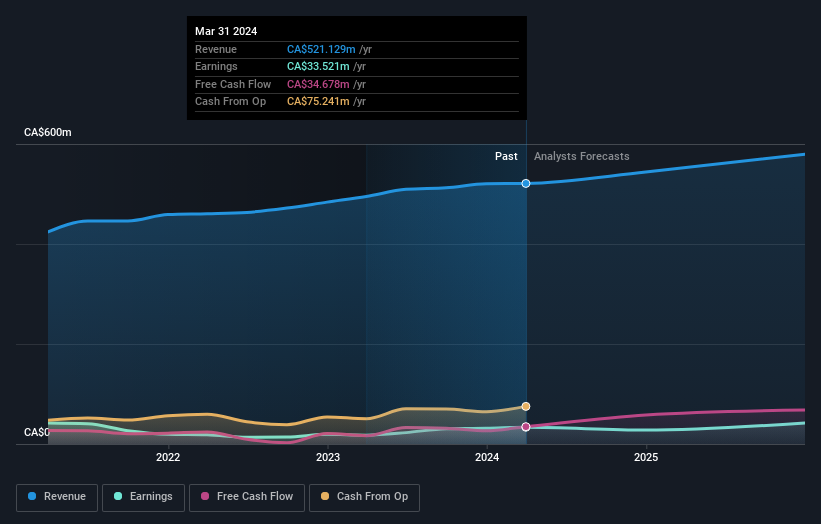With 64% ownership in Pollard Banknote Limited (TSE:PBL), insiders continue to have the largest holding even though they have sold shares recently
Key Insights
Significant insider control over Pollard Banknote implies vested interests in company growth
The top 3 shareholders own 64% of the company
If you want to know who really controls Pollard Banknote Limited (TSE:PBL), then you'll have to look at the makeup of its share registry. And the group that holds the biggest piece of the pie are individual insiders with 64% ownership. Put another way, the group faces the maximum upside potential (or downside risk).
Despite selling some shares recently, insiders control a good portion of the company's stock.
In the chart below, we zoom in on the different ownership groups of Pollard Banknote.
Check out our latest analysis for Pollard Banknote
What Does The Institutional Ownership Tell Us About Pollard Banknote?
Many institutions measure their performance against an index that approximates the local market. So they usually pay more attention to companies that are included in major indices.
We can see that Pollard Banknote does have institutional investors; and they hold a good portion of the company's stock. This suggests some credibility amongst professional investors. But we can't rely on that fact alone since institutions make bad investments sometimes, just like everyone does. It is not uncommon to see a big share price drop if two large institutional investors try to sell out of a stock at the same time. So it is worth checking the past earnings trajectory of Pollard Banknote, (below). Of course, keep in mind that there are other factors to consider, too.
Pollard Banknote is not owned by hedge funds. Because actions speak louder than words, we consider it a good sign when insiders own a significant stake in a company. In Pollard Banknote's case, its Top Key Executive, Gordon Pollard, is the largest shareholder, holding 21% of shares outstanding. The second and third largest shareholders are John Pollard and Douglas Pollard, with an equal amount of shares to their name at 21%. Note that two of the top three shareholders are also Co-Chief Executive Officer and Member of the Board of Directors, respectively, once again pointing to significant ownership by company insiders.
To make our study more interesting, we found that the top 3 shareholders have a majority ownership in the company, meaning that they are powerful enough to influence the decisions of the company.
Researching institutional ownership is a good way to gauge and filter a stock's expected performance. The same can be achieved by studying analyst sentiments. There are a reasonable number of analysts covering the stock, so it might be useful to find out their aggregate view on the future.
Insider Ownership Of Pollard Banknote
The definition of company insiders can be subjective and does vary between jurisdictions. Our data reflects individual insiders, capturing board members at the very least. The company management answer to the board and the latter should represent the interests of shareholders. Notably, sometimes top-level managers are on the board themselves.
Insider ownership is positive when it signals leadership are thinking like the true owners of the company. However, high insider ownership can also give immense power to a small group within the company. This can be negative in some circumstances.
Our information suggests that insiders own more than half of Pollard Banknote Limited. This gives them effective control of the company. That means they own CA$555m worth of shares in the CA$862m company. That's quite meaningful. Most would be pleased to see the board is investing alongside them. You may wish todiscover (for free) if they have been buying or selling.
General Public Ownership
The general public-- including retail investors -- own 22% stake in the company, and hence can't easily be ignored. While this group can't necessarily call the shots, it can certainly have a real influence on how the company is run.
Next Steps:
It's always worth thinking about the different groups who own shares in a company. But to understand Pollard Banknote better, we need to consider many other factors. For instance, we've identified 1 warning sign for Pollard Banknote that you should be aware of.
Ultimately the future is most important. You can access this free report on analyst forecasts for the company.
NB: Figures in this article are calculated using data from the last twelve months, which refer to the 12-month period ending on the last date of the month the financial statement is dated. This may not be consistent with full year annual report figures.
Have feedback on this article? Concerned about the content? Get in touch with us directly. Alternatively, email editorial-team (at) simplywallst.com.
This article by Simply Wall St is general in nature. We provide commentary based on historical data and analyst forecasts only using an unbiased methodology and our articles are not intended to be financial advice. It does not constitute a recommendation to buy or sell any stock, and does not take account of your objectives, or your financial situation. We aim to bring you long-term focused analysis driven by fundamental data. Note that our analysis may not factor in the latest price-sensitive company announcements or qualitative material. Simply Wall St has no position in any stocks mentioned.
Have feedback on this article? Concerned about the content? Get in touch with us directly. Alternatively, email editorial-team@simplywallst.com

 Yahoo Finance
Yahoo Finance 

